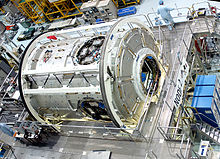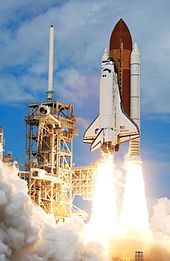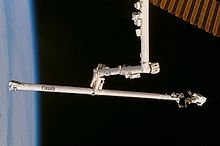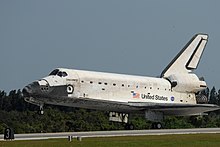STS-120
| Mission emblem | |||
|---|---|---|---|
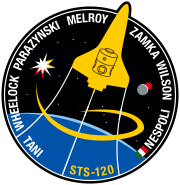
|
|||
| Mission dates | |||
| Mission: | STS-120 | ||
| COSPAR-ID : | 2007-050A | ||
| Crew: | 7th | ||
| Begin: | October 23, 2007, 15:38:19 UTC | ||
| Starting place: | Kennedy Space Center , LC-39A | ||
| Space station: | ISS | ||
| Coupling: | October 25, 2007, 12:40 UTC | ||
| Decoupling: | November 5, 2007, 10:32 UTC | ||
| Duration on the ISS: | 10d 21h 52min | ||
| Number of EVA : | 4th | ||
| Landing: | November 7, 2007, 18:01:18 UTC | ||
| Landing place: | Kennedy Space Center, Lane 33 | ||
| Flight duration: | 15d 2h 22min 59s (until touchdown) |
||
| Earth orbits: | 238 | ||
| Rotation time : | 91.4 min | ||
| Apogee : | 344 km | ||
| Perigee : | 340 km | ||
| Covered track: | 10.05 million km | ||
| Payload: | Harmony | ||
| Team photo | |||
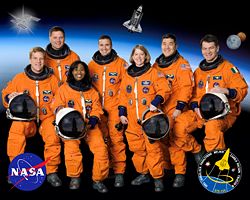 v. l. No. Scott Parazynski, Douglas Wheelock, Stephanie Wilson, George Zamka, Pamela Melroy, Daniel Tani and Paolo Nespoli |
|||
| ◄ Before / After ► | |||
|
|||
STS-120 ( english S pace T ransportation S ystem) is the mission name for the 34th flight of the US Space Shuttle Discovery (OV-103) of NASA . It was the 120th space shuttle mission. The launch took place on October 23, 2007.
team
- Pamela Melroy (3rd space flight), commander
- George Zamka (1st space flight), pilot
- Scott Parazynski (5th spaceflight), mission specialist
- Stephanie Wilson (2nd spaceflight), mission specialist
- Douglas Wheelock (1st spaceflight), mission specialist
-
Paolo Nespoli (1st space flight), Mission Specialist ( ESA / Italy )


ISS crew outward flight
- Daniel Tani (2nd space flight), flight engineer
ISS crew return flight
ISS expedition 15 / ISS expedition 16
- Clayton Anderson (1st spaceflight), flight engineer
Mission overview
The main payload of STS-120 was the Harmony interconnection hub , which was brought to the International Space Station . During the first spacecraft mission, Harmony was temporarily attached to the Unity module . After the flight, the module was moved to its final location at the Destiny laboratory by the space station crew. This was necessary because the space shuttle itself was docked to the Destiny module during the mission. In addition, the P6 solar module was moved to its position on the port end of the lattice structure .
The mission was one of the most complicated and, at 15 days, is one of the longest in shuttle history. Of the original five field missions , one was canceled because a sun wing on the ISS was torn and had to be sewn. The exit, in which Scott Parazynski repaired the crack, was risky but could be carried out successfully.
Preparations
After the end of the last Discovery mission ( STS-116 ) on December 22, 2006, the space shuttle was driven into the Orbiter Processing Facility . There the routine follow-up checks and the repair of the damage that had occurred during the flight took place. Afterwards, some changes were made to the Discovery that had previously received the sister ferry Endeavor : the new SSPTS energy transfer system ( Station-to-Shuttle Power Transfer System ) was installed. With this the orbiter draws power from the space station during the coupling and can thus extend its stay. In addition, the outdated TACAN navigation system was replaced by GPS .
On May 2, the freight train that was supposed to deliver the booster segments for this and the next mission at the Kennedy Space Center (KSC) crashed when a low bridge collapsed. Six people were injured, one of them seriously. The train was on its way from manufacturer ATK in Utah to KSC in Florida when it derailed in the state of Alabama .
On July 18, the construction of the two boosters , each consisting of four segments , began in the Vehicle Assembly Building (VAB) . The assembly was completed in four weeks.
The mission's outer tank was loaded onto a launch on July 24th and transported from the Michoud Assembly Facility from Louisiana to Florida. After five days the tank reached the KSC and was brought to the VAB on July 30th.
After foam parts had detached from the outer tank during the previous flight of the orbiter Endeavor ( STS-118 ) at the beginning of August 2007, the assembly of the tank between the two boosters planned for August 20 was postponed. Instead, the areas of the fuel line where the insulation flaked were x-rayed. Fine cracks were discovered. On August 24th, Wayne Hale , director of the shuttle program, announced that the insulation foam covers that cover the clamps on the external fuel line for the liquid oxygen would be modified. This work was completed after a week and a half, so that the tank could be connected to the solid fuel rocket on September 5th.
On September 17, NASA decided to postpone the transfer of the Discovery from the maintenance hangar to the VAB because a leak had been discovered on one of the chassis a few days earlier. The orbiter's right main landing gear lost hydraulic fluid and the corresponding parts had to be replaced. Two days after the announcement, the repairs were carried out in the OPF. The shock absorber received four new seals after most of the chassis had to be removed.
Due to the additional work, the transfer of the orbiter to the assembly hall was delayed by four days - the Discovery could only be driven to the VAB on September 23. Two days later, the space shuttle was assembled there with the external tank and the two solid fuel rockets.
The Discovery arrived at the launch pad on September 30th. The five and a half kilometer long transport had to be postponed ten hours due to bad weather. A little later, technicians loaded Harmony into the space shuttle's hold.
At the beginning of a two-day conference in preparation for the flight readiness acceptance - at the same time the team at KSC completed the countdown dress rehearsal - it was announced on October 9th that there were safety concerns about the airworthiness of three RCC (Reinforced Carbon Carbon) panels on the wing leading edges. The upper protective layer had partially peeled off, which could have led to a burn through during re-entry and caused an accident similar to that of the STS-107 .
During the flight readiness review, the flight readiness acceptance, the preliminary start date - October 23 - was confirmed on October 16. Shuttle program manager Wayne Hale then explained that there was no need to change the three RCC panels in question (one on the left wing, two on the right wing). In the worst case, only the coating could come off during re-entry.
Mission history
begin
One day after the crew arrived from Houston, Florida on October 19, the countdown to the mission began. The weather forecast for the start day initially assumed a probability of 60 percent for good weather. An expected low cloud cover and a few rain areas lowered the forecast for a start on October 23 to 40 percent.
At the suggestion of start director Mike Leinbach, the countdown of this mission had been changed slightly in advance. In order to counteract the formation of ice on the outer tank, the time that the tank filled with cryogenic fuels stands on the ramp should be shortened. For this purpose, the holding time at T-3 hours, which began immediately after refueling, was reduced from three to two and a half hours in the countdown. In addition, the refueling process started half an hour later. This saved an hour.
On October 23, while the external tank was being refueled, the sky cleared over the KSC and the probability of a start had risen to 80 percent. The emergency landing sites in Moron and Istrès also reported good weather.
After the crew boarded the Discovery, ice was found on the outer tank, which under certain circumstances would have made it necessary to abort the take-off. However, NASA decided to start because the ice had receded. The Discovery took off on the first attempt to take off on October 23, 2007 at 15:38:19 UTC.
Inspection and coupling
As has been customary since STS-114 , on the second day of flight (October 24) the particularly sensitive parts of the heat shield were checked for damage using the OBSS inspection arm ( Orbiter Boom Sensor System ). One after the other, the wings and the orbital nose were scanned. First evaluations did not reveal any damage.
On October 25, the third day of the mission, the coupling with the International Space Station took place at 12:40 UTC. One hour beforehand, the Discovery performed the mandatory 360 ° turn over the pitch axis. This enabled the ISS crew to take around 300 high-resolution photos of the heat shield. When the bulkheads were opened at 14:39 UTC, ISS Commander Peggy Whitson and Shuttle Commander Pamela Melroy welcomed each other for the first time, two women who were leading a space mission at the same time. On the same day, mission specialist Daniel Tani replaced ISS flight engineer Clayton Anderson by replacing the Soyuz seats. The new SSPTS energy transmission system was also activated, with which the Discovery obtained power from the ISS.
Working on the ISS
On the fourth day of flight (October 26), the first space exit of this mission began at 10:02 UTC. Parazynski and Wheelock first dismantled an S-band antenna, which was stowed in the Discovery's cargo bay and brought to earth. They then attached an anchor point for the ISS robot arm to the Harmony module so that it could lift Harmony out of the cargo bay. While Harmony was attached to Unity in its temporary location at 15:38 UTC, the two astronauts went to the P6 grid structure to sever some connections to the Z1 element . The EVA ended at 16:16 UTC.
On October 27, the fifth day of flight, Harmony was activated for the first time. In addition, another detailed inspection of the heat shield was rejected by flight control. The evaluation of the photos taken by the ISS crew while the Discovery was approaching did not reveal any signs of damage.
The second exit of Parazynski and Tani began on October 28 at 9:32 UTC (sixth day of flight). First, P6 was detached from the Z1 element. Then the duo split up. Parazynski prepared Harmony for further work, while Tani went to the S3 / S4 module to check the Solar Alpha Rotary Joint (SARJ), the alignment mechanism of the solar cell carriers. In the past few weeks, strong friction and vibrations had been detected here. Tani discovered metal shavings, a sample of which he took with him for examination on the ground. Then P6 was “parked” in the free space. The EVA lasted a total of 6 hours and 33 minutes.
On October 29th, the seventh day of the mission, P6 was passed from arm to arm like a relay race. From the parking position, the solar module was first transferred from the ISS arm to the Discovery's robotic arm so that the station arm could move to the outer port end of the lattice structure. There P6 was taken over again by Canadarm2 and brought to its final position. In addition, the S1 radiators were deployed.
The rest of the crew outfitted Harmony throughout the day. In addition, the flight control decided to extend the mission by one day in order to examine the problems at SARJ more closely during the fourth EVA.
During the mission's third spacecraft operation, which began October 30 at 8:45 UTC, Parazynski and Wheelock finally installed P6 on the port end of the ISS lattice structure. Controlled by Stephanie Wilson and Daniel Tani, the robot arm of station P6 had maneuvered directly up to P5 so that Wheelock and Parazynski could connect both elements. Parazynski then examined the SARJ port swivel joint. The NASA engineers wanted to receive comparative values in order to track down the problem of the other SARJ. The astronaut reported that it looked flawless and that he could not see any contamination. The EVA ended after seven hours and eight minutes.
After finishing the exit, Mission Specialist Wheelock found a small hole in the top layer of his glove. He found a two by three millimeter crack on his right thumb. The flight control instructed Wheelock to use a spare glove for the next field trip.
After the exit, the solar cell surfaces of P6 were extended again. While there were no problems with the 2B wing, the crew discovered damage on the 4B wing. The extension was then canceled at a length of 80 percent and various photos of the wing were taken from different angles. It was also reported that the P6 collector was delivering 95 percent of its normal current yield.
On October 31 (ninth day of flight) the crew made preparations for the fourth exit. Wheelock and Parazynski familiarized themselves with the new processes because the tasks were changed. The demonstration of repair techniques on heat protection tiles was canceled. Instead, only the SARJ starboard joint problem should be addressed the next day.
At the beginning of the tenth mission day (November 1), the flight control informed the astronauts that the exit had been postponed to November 3. This gives the engineers enough time to work out the repair techniques. The exact evaluation of the recordings made by the crew of the defective 4B panel revealed two cracks, the larger of which was almost a meter long. NASA's concern was not a reduction in energy, but a loss of stability.
Interrupted by a brief conversation with former US President George Bush , who was visiting the Johnson Space Center with his wife , the astronauts prepared the tools required for the upcoming exit on November 1st and 2nd. Stabilizers were made from 20 meters of wire, aluminum strips and screw connections in order to relieve the damaged part of the wing and prevent further tearing.
According to Michael Suffredini, the head of the ISS program, one of the three guide ropes likely got caught in an eyelet and caused the tear. When exiting, attempts should be made to loosen the rope and take the tension off the structure. If the repair attempt fails, you can do another one the following day. As a precaution, it was decided to forego the originally planned fifth field mission and to have it carried out by the ISS crew after the Discovery separated.
Astronauts Parazynski and Wheelock left the airlock Quest at 10:03 UTC on November 3rd (12th day of flight) to begin repairs. The ISS robot arm had previously been connected to the OBSS inspection arm in order to be able to reach the inaccessible area. Parazynski attached himself to the end of the OBSS using a footrest. He clamped the solar wing with five self-made wire loops to close the two cracks and prevent them from enlarging. He also loosened the tangled tension wires. To avoid touching the high-voltage panel, Parazynski used tools taped off with electrical tape - a spacer resembling a hockey stick and pliers. Wheelock assisted from the base of the P6 launcher by giving instructions to Stephanie Wilson, who operated the robotic arm, and making sure that Parazynski kept a safe distance from the wing. After the successful repair, the 4B panel was fully unfolded and the two "craftsmen" returned to the airlock. The exit ended after 7 hours and 19 minutes.
On November 4, the last goods were brought into the station from the space shuttle and the STS-120 crew said goodbye. At 20:03 UTC the hatches between Discovery and ISS closed.
return
As planned, on November 5th (14th day of flight) at 10:32 UTC the Discovery cast off from the space station after 10 days and 22 hours. After an hour and a half orbit, the orbiter departed from the ISS. For the rest of the day, the crew used the OBSS to inspect the orbiter's heat shield for damage.
November 6th was used to test the systems required for landing and to stow equipment. To make the re-entry phase easier for Anderson, a special reclining seat was set up for him in the middle deck. Melroy and Zamka also trained the landing with the PILOT laptop (Pilot Inflight Landing Operations Trainer).
After the wake-up call on November 7 (16th day of flight), the crew began preparations for landing. The KSC had the first option at 18:02 UTC. Before flight control gave the crew the green light at 16:49 UTC, the cargo hold doors had been closed and the main computer programmed two and a half hours earlier. At 16:59 UTC the landing maneuver was initiated with the brake ignition . One hour later, at 18:01:18 UTC, the Discovery landed safely on runway 33 of the Shuttle Landing Facility .
The return flight differed from the earlier shuttle landings: for the first time since the Columbia crash in 2003, the route was routed across large parts of the USA. The reason was Commander Melroy's wish to be allowed to land in daylight. Originally the Discovery was supposed to return at night. The approach would have been over the South Pacific, Central America and the Gulf of Mexico. Due to the flight extension, there were only two landing options in Florida on the 16th mission day (18:02 UTC and 19:36 UTC), each of which led via the North Pacific, the northwestern United States to Florida.
An hour after landing, the crew disembarked the Discovery and undertook the mandatory inspection of the ferry. Clay Anderson was unable to take part in it after around five months in space due to his muscle weakness. Paolo Nespoli was also not present at the “walkaround” because he was still being examined medically.
After the backup work, the Discovery was towed to the Orbiter Processing Facility, where it was prepared for its next mission ( STS-124 ).
See also
Web links
- NASA: Official Mission Site (English)
- Space Science Journal: Mission STS-120
- NASA: Photo gallery (English)
- Video summary with comments of the crew (English)
swell
- ↑ CNN.com: Train carrying shuttle rockets derails ( Memento from May 6, 2007 in the Internet Archive ), May 2, 2007 (English)
- ↑ NASA: Space Shuttle Processing Status Report S-072007 , July 20, 2007 (English)
- ↑ NASASpaceflight.com: ET-120 X-Ray evaluations find crack-like indications in brackets , August 23, 2007 (English)
- ↑ NASASpaceflight.com: Repaired ET-120 ready for mating - Discovery prepped for rollover , September 4, 2007 (English)
- ↑ SPACE.com: NASA Tests Leak Fix for Shuttle Discovery , September 21, 2007 (English)
- ↑ Florida Today Blog: NASA rolls shuttle Discovery to launch pad ( Memento from October 28, 2007 in the Internet Archive ), September 30, 2007 (English)
- ↑ Florida Today: Wing problems could delay shuttle , October 11, 2007 (English)
- ↑ NASA: NASA Gives "Go" for Space Shuttle Launch on Oct. October 23 , 2007
- ↑ NASA: NASA'S Shuttle Discovery Begins Mission to the Space Station , October 23, 2007 (English)
- ↑ Florida Today: Station grows with Harmony , October 27, 2007 (English)
- ↑ Florida Today: Flakes trouble at space station , October 29, 2007 (English)
- ↑ NASA: STS-120 MCC Status Report # 20 , November 1, 2007 (English)
- ↑ USA Today: NASA: Spacewalk will have 'higher risk than usual' , November 2, 2007 (English)
- ↑ NASA: STS-120 MCC Status Report # 24 , November 3, 2007 (English)
- ↑ NASA: Shuttle Discovery Crew Returns Home After Successful Mission , November 7, 2007 (English)
- ↑ NASA: STS-120 Landing Ground Track , November 5, 2007 (English)

